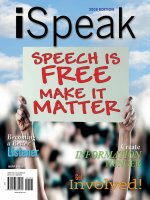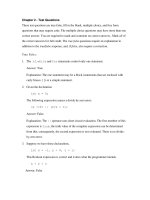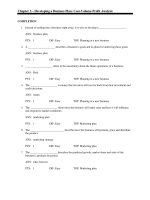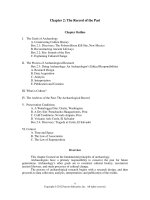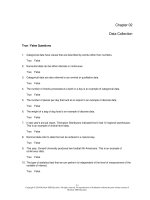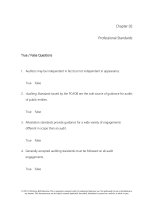iSpeak 2013 public speaking for contemporary life 5th edition nelson test bank
Bạn đang xem bản rút gọn của tài liệu. Xem và tải ngay bản đầy đủ của tài liệu tại đây (283.38 KB, 9 trang )
Chapter 2 Preparing Your First Presentation
Chapter 2 Preparing Your First Presentation
Essay
1. List and describe the Five Canons of Rhetoric.
Ans: Answers will vary.
2. Describe the process of invention and provide specific examples of how you could engage in the
invention process when preparing for a presentation.
Ans: Answers will vary.
3. Explain at least three ways that you could use the key skills of the invention process when
preparing for your speeches.
Ans: Answers will vary
4. Explain some ways that you could use the invention process to narrow a topic.
Ans: Answers will vary
5. Explain how a concept map could be used to engage effectively in the invention process.
Besides helping with invention, identify at least one other way that a concept map could help you in
preparing for a presentation.
Ans: Answers will vary.
6. Identify the parts of a presentation and the functions that each serves.
Ans: Answers will vary.
7. Discuss how clarity and ornamentation are distinct from one another as well as how they each
contribute to style.
Ans: Answers will vary.
8. Explain strategies you could use to use style more effectively in your presentation.
Ans: Answers will vary.
9. Effective delivery requires a presenter to balance what are sometimes conflicting issues: being
professional and being oneself. Identify and explain key delivery characteristics that can help you
appear professional to your audience, while at the same time being true to your own personality and
sense of self.
Ans: Answers will vary.
10. Briefly explain what is meant by the statement “The Canons of Rhetoric are biased toward a
Western view of rhetoric.” What alternatives to this Western view exist?
Ans: Answers will vary
11. Using the “Tips for Planning Your Presentation” discussed in chapter 2, describe one
suggestion that has the potential to help you the most with your first speech. To answer this
Nelson: iSpeak 2013
TB-2 | 1
© 2014 by McGraw-Hill Education. This is proprietary material solely for authorized instructor use. Not authorized for sale or distribution in any
manner. This document may not be copied, scanned, duplicated, forwarded, distributed, or posted on a website, in whole or part.
Chapter 2 Preparing Your First Presentation
question, you should attempt to identify some areas of growth that you have as a speaker and then
analyze how one of the tips could help you improve in that area.
Ans: Answers will vary.
12. Explain a strategy for how you should use note cards during your presentations.
Ans: Answers will vary.
13. Using the “Tips for Planning Your Presentation” discussed in Chapter 2, explain at least two
concrete strategies that you can use to improve your delivery when presenting.
Ans: Answers will vary.
14. Describe the characteristics of an impromptu presentation and also explain one or more
specific strategies that you could use when delivering an impromptu presentation.
Ans: Answers will vary.
15. Explain how you can most effectively plan a speech in which you will present yourself to your
class.
Ans: Answers will vary
16. Explain techniques that you should use to effectively interview a classmate in preparation for a
speech of introduction. How could these principles be adapted to interviewing others (experts, for
example) in preparation for an informative or persuasive presentation?
Ans: Answers will vary.
17. Provide an example of a demonstration presentation that you could develop from your own
personal interests and experiences. You should describe the topic, identify main points, and
describe how you could effectively integrate visual aids into the message.
Ans: Answers will vary.
18. Discuss how you can use ethos, pathos, and logos in your speeches.
Ans: Answers will vary.
True/False
19. The Five Canons of Rhetoric are a contemporary (i.e., recent) set of theories explaining the
process of preparing a public presentation.
Ans: false
20. Ornamentation is the overuse of flowery language that adds nothing to the speech.
Ans: false
21. You develop the substance of your presentation by engaging in the invention process.
Ans: true
22. During the process of invention, you should take the perspective that style is more important
than substance.
Nelson: iSpeak 2013
TB-2 | 2
© 2014 by McGraw-Hill Education. This is proprietary material solely for authorized instructor use. Not authorized for sale or distribution in any
manner. This document may not be copied, scanned, duplicated, forwarded, distributed, or posted on a website, in whole or part.
Chapter 2 Preparing Your First Presentation
Ans: False
23. During invention, the first stage of preparing a presentation, you should try to look at a
problem only from the perspective of audience members who would disagree with your message.
Ans: false
24. During the invention stage, you will prepare an introduction.
Ans: false
25. During the organization stage you will try to determine what issues are related to your topic.
Ans: false
26. When organizing your presentation you should make sure that all the main points have enough
supporting material.
Ans: true
27. When you are trying to decide which topic you will cover first during your presentation, you
are engaging in the organization process.
Ans: false
28. A concept map can be used to help narrow the focus of your presentation.
Ans: true
29. The central idea or thesis statement must be presented in the first main point of the body of
your presentation.
Ans: false
30. You should start the invention process by organizing the body of a speech, and then the
introduction.
Ans: false
31. Beginning a speech with a metaphor or analogy is a distracting way to plan an introduction.
Ans: false
32. Your very last move in an effective conclusion is to summarize the points covered during your
presentation.
Ans: false
33. Clarity is the aspect of style that allows rhetoric to be artful.
Ans: false
34. Clarity refers both to the use of easily understood language as well as the arrangements of
words.
Ans: true
35. Narrative involves the use of stories and/or examples.
Nelson: iSpeak 2013
TB-2 | 3
© 2014 by McGraw-Hill Education. This is proprietary material solely for authorized instructor use. Not authorized for sale or distribution in any
manner. This document may not be copied, scanned, duplicated, forwarded, distributed, or posted on a website, in whole or part.
Chapter 2 Preparing Your First Presentation
Ans: true
36. Narratives are a primary tool for adding clarity to a presentation.
Ans: false
37. To add clarity to your presentation you should script out your message.
Ans: false
38. The Understanding Canon refers to speaking clearly and enunciating words accurately so the
audience will be able to hear everything.
Ans: false
39. The Canons of Rhetoric stem from Western philosophy.
Ans: true
40. To engage in effective delivery means that you memorize the wording of your presentation.
Ans: false
41. The discussion of rhetoric in Chapter 2 is biased toward Egyptian perspectives and scholarship.
Ans: false
42. When presenting yourself to the class, you should avoid talking about the details of your
background.
Ans: false
43. An impromptu presentation requires substantial practice, but does not allow for substantial
preparation.
Ans: false
44. When preparing a demonstration, you should have a main point for each step in the process
you are presenting.
Ans: false
45. Pathos refers to ethical proof or credibility.
Ans: false
Multiple Choice
46. Which of the Canons of Rhetoric focuses on using verbal and nonverbal techniques to
maximize the effectiveness of your message?
a. Understanding
b. Delivery
c. Style
d. Invention
Answer: b
Nelson: iSpeak 2013
TB-2 | 4
© 2014 by McGraw-Hill Education. This is proprietary material solely for authorized instructor use. Not authorized for sale or distribution in any
manner. This document may not be copied, scanned, duplicated, forwarded, distributed, or posted on a website, in whole or part.
Chapter 2 Preparing Your First Presentation
47. For which of the Five Canons of Rhetoric would you plan to use metaphors and/or analogies to
increase the artful ornamentation of language in your presentation?
a. Delivery
b. Organization
c. Style
d. Understanding
Answer: c
48. For which of the Five Canons of Rhetoric would you conduct research to supplement your own
personal knowledge?
a. Understanding
b. Delivery
c. Style
d. Invention
Answer: d
49. For which of the Five Canons of Rhetoric would you most likely use a concept map to identify
sub-topics associated with your overall topic?
a. Invention
b. Organization
c. Understanding
d. Style
Answer: a
50. When engaging in the invention process, you should do all of the following EXCEPT
a. identify issues related to the topic.
b. use language, metaphors, and analogies.
c. predict what your audience wants to know.
d. conduct research to supplement personal knowledge.
Ans: b
51. When engaging in organization you should concentrate on
a. finding different angles on your topic.
b. memorizing your message.
c. planning the main points.
d. determining audience perceptions.
Ans: c
52. To enable listeners to follow your ideas easily, how many main points should you have in the
body of your presentation?
a. One for each circle on the concept map that you create
b. One for each PowerPoint slide
c. Approximately 5 or 6
d. Approximately 2 or 3
Answer: d
Nelson: iSpeak 2013
TB-2 | 5
© 2014 by McGraw-Hill Education. This is proprietary material solely for authorized instructor use. Not authorized for sale or distribution in any
manner. This document may not be copied, scanned, duplicated, forwarded, distributed, or posted on a website, in whole or part.
Chapter 2 Preparing Your First Presentation
53. Of the phrases below, which one is most likely a main idea for a presentation on pollution
rather than a supporting point?
a. Rise in sea levels
b. Effects of environmental pollution
c. Destruction of species
d. Increase in incidence of asthma
Answer: b
54. The Canon of Rhetoric that deals with style includes
a. defining important points.
b. maintaining consistent eye contact.
c. preparing an introduction.
d. avoiding reading the presentation.
Ans: a
55. Which of the following is NOT an approach to invention?
a. Asking the right questions
b. Selecting relevant information
c. Avoiding speeches about old topics
d. Looking at a problem from all sides
Answer: c
56. Which of the following techniques could be used to increase the ornamental style of your
speech?
a. Using narratives
b. Avoiding long sentences
c. Defining technical terms
d. Preparing a script for the presentation
Answer: a
57. The statement, “My spring break trip was a train wreck because everything that could go
wrong, did go wrong,” illustrates the use of _____________ to improve style.
a. precision
b. narrative
c. metaphor
d. disposition
Answer: c
58. Alfonso includes in his speech a story about his experiences as a young man. This is an
example of the use of
a. metaphor.
b. narrative.
c. analogy.
d. definition.
Answer: b
Nelson: iSpeak 2013
TB-2 | 6
© 2014 by McGraw-Hill Education. This is proprietary material solely for authorized instructor use. Not authorized for sale or distribution in any
manner. This document may not be copied, scanned, duplicated, forwarded, distributed, or posted on a website, in whole or part.
Chapter 2 Preparing Your First Presentation
59. According to Chapter 2 in the textbook, the single most common ineffective delivery habit
among inexperienced presenters is
a. reading a presentation.
b. failing to use PowerPoint.
c. not striving for perfection.
d. speaking too rapidly.
Answer: a
60. Janelle was sitting in class when Professor Davis asked her to talk about her experiences while
participating in a summer internship. What type of presentation is Janelle being asked to give?
a. Instructional
b. Impromptu
c. Extemporaneous
d. Preparatory
Answer: b
61. Antwan was taking notes for his upcoming presentation and trying to determine whether his
primary goal was to teach, persuade, or entertain the audience. Which Canon of Rhetoric best
describes this stage of speech preparation?
a. Style
b. Delivery
c. Organization
d. Invention
Answer: d
62. In his presentation on hurricanes, Richard said, “The information I will show you about
hurricanes will just blow you away.” Richard’s attempt to use language creatively is connected to
which Canon of Rhetoric?
a. Style
b. Delivery
c. Understanding
d. Invention
Answer: a
63. Which of the following is NOT one of Aristotle’s proofs?
a. Logos
b. Argos
c. Pathos
d. Ethos
Answer: b
64. What type of presentation does NOT allow for substantial planning prior to the presentation?
a. Extemporaneous
b. Memorized
c. Demonstration
d. Impromptu
Nelson: iSpeak 2013
TB-2 | 7
© 2014 by McGraw-Hill Education. This is proprietary material solely for authorized instructor use. Not authorized for sale or distribution in any
manner. This document may not be copied, scanned, duplicated, forwarded, distributed, or posted on a website, in whole or part.
Chapter 2 Preparing Your First Presentation
Ans: d
65. To easily distinguish between main and subordinate points in speaking notes, you should
a. place main points on one card and subordinate points on another.
b. eliminate supporting material from subordinate points.
c. use different colors of ink for main and subordinate points.
d. rephrase your subordinate points so they are more general.
Ans: c
66. Nonverbal delivery during a speech should be
a. natural.
b. subdued.
c. unrehearsed.
d. precise.
Ans: a
67. Caring about your community and society is known as
a. canons of rhetoric.
b. public communicaton.
c. cognizance of current events.
d. civic engagement.
Ans: d
68. Organization is best associated with the ______ of information.
a. arrangement
b. delivery
c. discovery
d. evaluation
Ans: a
69. SiSi’s teacher commented that she did not effectively use language in her presentation. Some
words were too technical and other words were too vague. The teacher’s comments are related to
which canon of rhetoric?
a. Understanding
b. Style
c. Delivery
d. Ornamentation
Ans: b
70. During a demonstration presentation, Spencer wanted to discuss how to reduce the risk to your
home from wildfires. When planning his presentation, Spencer should
a. avoid using visual aids.
b. emphasize his personal interest.
c. develop main points for each of the seven steps.
d. relate the topic to the listeners.
Ans: d
Nelson: iSpeak 2013
TB-2 | 8
© 2014 by McGraw-Hill Education. This is proprietary material solely for authorized instructor use. Not authorized for sale or distribution in any
manner. This document may not be copied, scanned, duplicated, forwarded, distributed, or posted on a website, in whole or part.
Chapter 2 Preparing Your First Presentation
71. What do the authors of your text call your “secret weapon” as a presenter?
a. Voice
b. Style
c. Eye contact
d. Scripted delivery
Ans: c
Nelson: iSpeak 2013
TB-2 | 9
© 2014 by McGraw-Hill Education. This is proprietary material solely for authorized instructor use. Not authorized for sale or distribution in any
manner. This document may not be copied, scanned, duplicated, forwarded, distributed, or posted on a website, in whole or part.
